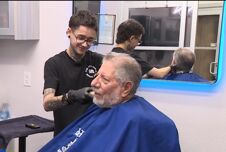In Joseph F. Lovett’s 2005 documentary, Gay Sex in the 70s, survivors of the 1970s reminisce about gay life in New York City during the hectic decade between the Stonewall Uprising and the AIDS epidemic.
Listening to the likes of Arnie Kantrowitz, Lawrence Mass, Tom Bianchi, and even Larry Kramer wax nostalgic about the good old days, I thought about the French statesman Talleryand who, having survived both the French Revolution and Napoleon, said that “he [or she] who has not lived in the years around 1780 has not known the pleasure of life.” Talleyrand, of course, was one of the lucky ones. Like the veterans in Gay Sex in the 70s (and Talleyrand) I am fortunate to be alive to tell my story. And while I was not featured in Lovett’s documentary — a New York-centered movie that ignored what was going on elsewhere at the time — I told my story in various anthologies and in Rebels, Rubyfruit, and Rhinestones (2001), James T. Sears’s ’70s history of the LGBT South.
My presence in Professor Sears’s book, unlike Talleyrand’s in French history, is serendipitous: I was in the right place at the right time doing the right thing. Even so, this experience allowed me to join the likes of Jack Fritscher, Brad Gooch, Ethan Mordden, Felice Picano, Edmund White, and the heroes of Gay Sex in the 70s.
Today, we tend to idealize the post-Stonewall, pre-AIDS decade as a golden age of gay sex. Like most men of a certain age, we who survived the disco era tend to exaggerate our youthful sexual experiences. And like Talleyrand’s aristocrats, only a minority of white gay men (and a few men of color), living in large cities of the United States, Canada, Australia, and Western Europe, were able to enjoy “the pleasure of [gay] life” in that crucial decade.
Never Miss a Beat
Subscribe to our newsletter to stay ahead of the latest LGBTQ+ political news and insights.
There certainly wasn’t much joy in being gay in the rural South, not to mention the Third World or behind the Iron Curtain. Most of us who were openly gay in Southern cities like Miami or Atlanta, New Orleans or Houston, were mostly young and poor and naive and very atypical. Most of the gay southern “A-listers,” who would have been the queens of gay society up north, were in the closet.
To be publicly gay was to court disaster, as was the case with the 28 gay men who perished in a fire that consumed the Up Stairs Lounge in New Orleans (1973). That someone like the late Logan Carter (a.k.a. “Roxanne Russell”) flourished in such a climate speaks volumes for Carter’s force of character — and his incredible talent.
If there was anything that characterized the men and women of the “Rubyfruit generation,” it was our innocence and our idealism. We really believed that we could make things better, for ourselves and for our brothers and sisters. Though we lost some of our innocence on June 7, 1977, the day the voters of Miami-Dade County, Florida, repealed their “gay rights” ordinance, we managed to keep our idealism intact throughout repeated electoral defeats, the assassination of Harvey Milk, and the “White Night” riots. The March on Washington for Lesbian and Gay Rights (1979) was, at least for the men, a celebration of gay sexual freedom as well as a political statement.
Many people who did not live through the ’70s view that decade as a period of unbridled decadence; and the people who were sexually active then as unprincipled libertines who sowed the seeds of their own destruction. This is unfair of course: people who cruised urban bars, baths, back rooms, parks, trucks, and docks from 1970 to 1979 could not know that AIDS was just around the corner.
I certainly don’t regret living through the gay seventies, though I would do anything to bring back the many friends that I’ve lost since then. It was wonderful to go through my prime at a time when the drinking age was 18, and when the worst you could get from sex (we thought) could be cured by a trip to the VD Clinic.
I was lucky (and privileged) to be involved in Florida’s LGBT movement during its early years; and to be out when most “community people” (to quote the semi-closeted leader of a semi-closeted group that flourished at that time) were not. And though the seventies was a period of separatism for both lesbians and gay men, I was blessed to have some wonderful women friends.
And finally, though I’ve lost my 70s innocence, I managed to retain my idealism throughout 35 years of grief and disappointment.















Living LGBT history: I survived the gay seventies